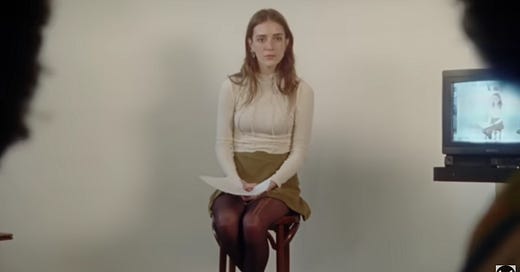You don’t see a lot of road trip pictures that address themselves to the Eastern Seaboard. The West, that frontier of empty space, majestic beauty, violent lawlessness, and mighty predatory animals, is a more typical setting, as is the South, with its gothic vistas, archaic customs, racists, and bayous. The Northeast, seat of government and finance and old universities we hear too much about, is perhaps impervious to adventures not of the kind of going to the city and either making it big or burning out and winding up in the gutter. Washington—a city of “people doing something real,” as the Magnetic Fields put it, tending to the trappings and logistics of Empire, I mean Democracy—who cares? Baltimore: a place for police procedurals with a social conscience. Philadelphia: a city for sitcoms, like Milwaukee, or topical melodramas, like Dallas. New Jersey: once a thriving locale of gambling, now a place for sports franchises that don’t bear its name and a shore of Springsteenian cliches. New York City: gentrified into a total nostalgia zone. New England: well, it’s a nice place to grow up.
I think I once called Sean Price Williams “the Gordon Willis of the Millennials” in a review of the Safdie Brothers’ Good Time, which he shot. I was probably off by a couple of years, so I apologize for generationally libeling him. The Sweet East is the first feature he’s directed, and he co-shot it. The screenplay is by Nick Pinkerton, one of the best American film critics and the author of an excellent book on Tsai Ming-liang’s Goodbye, Dragon Inn. Talia Ryder stars as Lillian, the heroine who makes her way from North Carolina to Vermont and back again. I’ve called it a road movie but there’s no single vehicle and Lillian, aka Annabel to some, has no single buddy to ride with but instead a series of companions who all more or less fall in love with her, to little avail. There is a bus, a van, a sports car, and a pick-up truck. There is mention of a catamaran. There is also a bag full of cash; a penis with a plethora of piercings, many guns, some of which are even loaded; old-timey outfits; a gang of radical militants who hold single-sex raves; a pastel-toned bed quilt emblazoned incongruously with notorious symbols, and an oversize T-shirt depicting the crop circles on the cover of Led Zeppelin’s 1990 career-spanning box set that law enforcement mistake for the work of another, superior band, a gag that compensates for the narrative’s failure ever to make it to Boston.
Beyond the beauty of the way it’s shot, of the original score and great new title song sung by the star, and of all the wonderful acting, and of the deadpan technique deployed generally, the genius of The Sweet East lies in part of putting so much invention into a picture, with such a light touch, while also maintaining a picaresque succession that turns out to be a progress and an education, without sacrificing the satisfactions of plot devices such as suspense, revenge, and comeuppance. Paced out in five main episodes, bookended by a prologue and epilogue that demonstrate that life at home was never and never will be enough for its heroine, the film lingers on its idyls, domestic and pastoral, then skips right along to urban passages of grit and glam.
The risks Williams and Pinkerton constantly run in The Sweet East are constant flirtations with topicality. In Washington Lillian is on a group trip with her boorish boyfriend Troy and a bunch of other students, many of whom are wearing unsightly bright yellow T-shirts. She slips away and into a dive bar that’s invaded by a live shooter who wants to be shown the basement where the child porn movies are filmed, shades of Pizzagate. The vision of the capital is of big sterile familiar buildings, plagued by loitering historical reenactors singing songs, and scummy locales where interlopers enact their berserk political fantasies. The rest of the film’s episodes spin out subtle variations of these contrasts. The anarchists Lillian falls in with in Baltimore are grungy but harmless and inept makers of so-so art undertaking political actions of dubious effectiveness. When she wanders away from them to pee in a field she comes upon the secret neo-Nazi rally they mean to disrupt and departs in the company of a nerdy white supremecist academic, an extreme and hilarious caricature of the incel as a tortured and repressed hobbyist (he collects moths and is obsessed with Poe), an incompetent and impotent paranoid counterrevolutionary. With a keen but not sadistic sense of their weaknesses, Lillian exploits these characters and moves on. At each turn a scenario that might signal a dive into culture war commentary veers instead into comedy of human foibles and thwarted desires. Her resourcefulness grows with each episode.
It is in New York City that Lillian approaches something like the mainstream liberal establishment, in the person of two filmmakers played in brilliant screwball style by Ayo Edebiri and Jeremy O. Harris, who spot Lillian on the street running with the duffel bag full of money and want to make her a star. The film they’re shooting is a historical feature that might be a revision of Gone with the Wind. Its nocturnal location shoot battle scene also serves as the climax of The Sweet East’s action. The thin (very thin) veil of realism that has so far attached to the proceedings is thrown off entirely. A kaleidoscopic set of visuals ensues amid the mayhem before yielding to a slow pastoral retreat and unwinding. Lillian’s safety and homecoming are finally secured by a figure of religious authority, appropriately portrayed by the indie rock icon Gibby Haynes of the Butthole Surfers, himself a symbol of the freewheeling American culture The Sweet East has renewed.


